Corporate Databases - 2016: Hot Top Ten
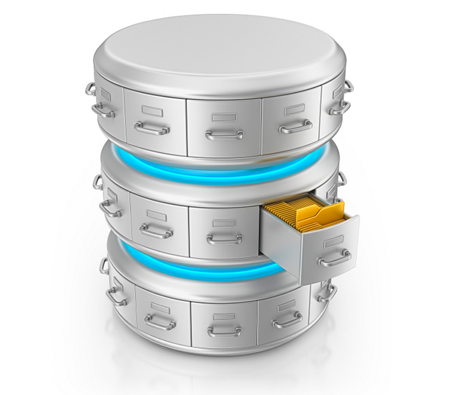 If your organization needs to store and process data, then, regardless of their size, you can’t do without a cloud or local DBMS. Today we will talk about the leading representatives of the corporate database market, about those developments that are worth paying attention to in 2016.
If your organization needs to store and process data, then, regardless of their size, you can’t do without a cloud or local DBMS. Today we will talk about the leading representatives of the corporate database market, about those developments that are worth paying attention to in 2016.The market for corporate databases has been around for several decades. We believe that, evaluating this or that system, it is useful, among other things, to take into account its history. But the maturity of the market does not mean that today it is a quiet and peaceful place. The level of competition here is very high.
Business requirements are constantly growing, changing approaches to the creation of IT-infrastructures. DBMS developers either manage to give the market what it wants, or find themselves on the periphery. And database users, thanks to the possibility of choice, benefit from this state of affairs.
This is not to say that choosing a corporate DBMS is easy, but we are sure that you will be able to find one that will interest you among the leading systems that we will talk about.
')
Oracle database
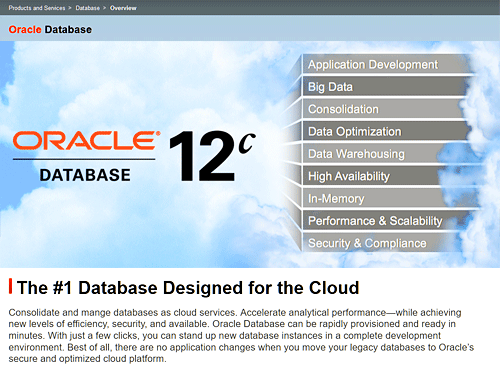
Oracle released its first relational database in 1979. Over the years of the company's presence on the market, the word “Oracle” has become synonymous with the concepts of “corporate DBMS” and “reliable work with data”. Oracle, as well as some other companies whose development is present in our review, is on the Fortune 500 list. Oracle’s main business is a powerful and rather complex database solution.
The current version of the company's DBMS is called Oracle 12c. The letter “c” means “cloud”. This reflects Oracle's move towards cloud technologies, which allow organizations to consolidate and manage databases as cloud services. Among the features of the Oracle DBMS is a multi-tenant architecture, fast deployment of solutions, data processing capabilities in memory.
Microsoft SQL Server
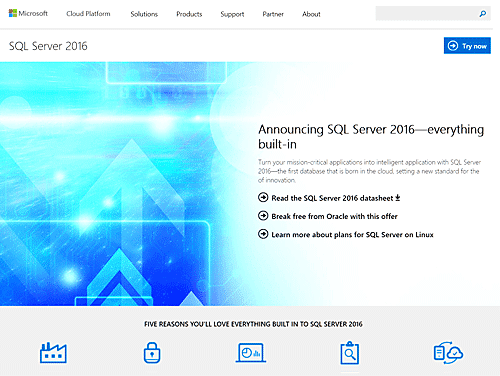
Anything can be said about Microsoft, but this is one of the most profitable technology companies in the world. Its desktop operating systems are literally everywhere, however, SQL Server played a significant role in the success of Microsoft. It’s hard to imagine a server running Microsoft’s OS without SQL Server.
The ease of use of SQL Server, its availability and tight integration with the Windows operating system make it an obvious choice for companies using Microsoft products for corporate purposes. Microsoft talks about the latest release of SQL Server 2016 as a platform for local and cloud databases, as well as for business intelligence systems.
In addition, Microsoft is promoting SQL Server 2016 as a solution that can help organizations build mission-critical transaction processing applications (OLTP). Such solutions are characterized by high performance, capabilities for data processing in memory and data protection during their storage and movement. On the basis of SQL Server 2016, you can create a large storage of data analysis systems.
There are various options for renting MS SQL Server . You can purchase a license for one user, you can license the server core, without limiting the number of users.
You can also download the free entry-level edition of SQL Server 2016 Express, which is best suited for deploying small databases in production environments and installing it on an inexpensive VPS , which is enough to create small server applications for processing data that takes up to 10 GB of disk space.
IBM DB2

It is said that IBM got the nickname “Blue Giant” because of its mainframes from the 50s and 60s, which occupied an entire room and were painted in the appropriate color. The company's efforts to promote DB2 , its ruthless competition with Oracle, suggest that IBM wants to fill many and many server rooms with computers on which its database is installed. There are studies on the comparison of comparable solutions from IBM and Oracle. For example, here you can look at the data report, which prepared the ITG. The report speaks of significant savings when using DB2 and related technologies IBM.
In April of this year, the latest version of the DBMS was released - DB2 11.1. It can work on many systems, in particular, on Linux, Unix and Windows, on IBM z Systems mainframes, supports hardware acceleration on Power 8 processors.
SAP ASE

The first release of the Sybase DBMS saw the light in 1987 under the name of SQL Server. He grew up in Adaptive Server Enterprise - the company's most famous and successful product. In 2010, Sybase was absorbed by SAP, with the result that today the database is called SAP Adaptive Server Enterprise (SAP ASE). Although Sybase has become part of another company, its DBMS is still one of the main players in the corporate market. In addition, Sybase is known for directing significant efforts to mobile corporate solutions, usually buying the developers of promising products. Apparently, SAP continues this tradition.
SAP ASE 16, the most recent release of DBMS, supports partition-level locking technology, integration with SAP HANA and SAP Business Suite. The database is economical, features effective scaling and system auditing, supports dynamic assignment of threads, optimize query plan with star connections and many other features .
PostgreSQL

PostgreSQL , the heir to Postgres, the development of which began in 1986, is a free, open source object-relational database. It is used in very interesting places like online casinos, data center automation systems, domain registries. In addition, it is used in high-load tasks Yahoo! and skype. PostgreSQL can be found in such a number of systems hidden from prying eyes that it may well be called the "Secret Corporate Database."
The current stable release of PostgreSQL is 9.6. It is released on September 29 of this year.
PostgreSQL supports many operating systems. Among them - Linux, Windows, FreeBSD, Solaris. PostgreSQL is used as a standard database in Apple's OS, starting with Mac OS X Lion. The capabilities of this DBMS are comparable with the developments of Oracle and IBM. In particular, it is characterized by full compliance with the requirements of the ACID transaction reliability, capable of supporting high parallel loads.
MariaDB Enterprise
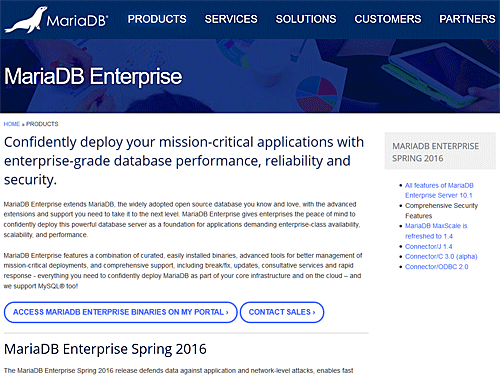
MariaDB Enterprise is a fully open source database released under GPL, LGPL or BSD licenses. The path MariaDB began in 2009 year. This system was a fork of MySQL, which was developed by a community of developers led by the creators of MySQL. They started a new project, concerned about the licensing policy of Oracle, which acquired MySQL.
Popular MariaDB has become due to MySQL. In particular, after MariaDB took the place of MySQL in the well-known Linux distributions. So, only in 2013, the developers of Red Hat Enterprise Linux abandoned MySQL in favor of MariaDB, the same was done in Fedora 19, and the switch to MariaDB was openSUSE and Slackware Linux. In addition, MariaDB has been used as a server database in the Wikipedia project.
Another major factor that caused MariaDB to be ahead of MySQL is the availability of an advanced query optimizer and other improvements regarding speed.
The latest release of MariaDB Enterprise Server is 10.1, also known as MariaDB Enterprise Spring 2016. This release improves data protection against attacks at the application and network levels and facilitates the development of new, high-performance applications.
Mysql
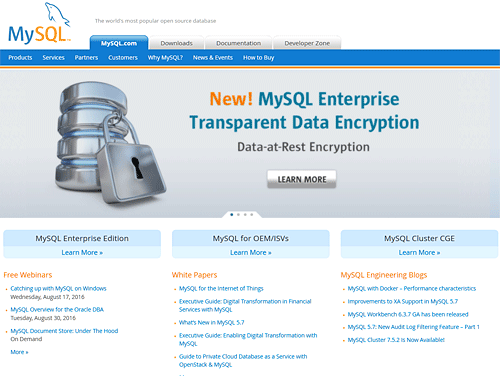
MySQL started out as a highly specialized solution for developers, but grew into one of the key players in the corporate DBMS market. First, in 2008, it was sold to Sun Microsystems, and later, in 2009, it became part of the Oracle empire. For many years, MySQL has been much more than a niche solution. MySQL has hundreds of thousands of commercial websites, it serves as a server-based database for a huge number of internal corporate applications.
Today, MySQL remains a very popular option for web solutions; it continues to serve as a central component of the LAMP stack. At the same time, MySQL, due to the takeover of Oracle, is experiencing a weakening of support from users and independent developers.
The fall in popularity of MySQL has made it possible to accelerate the adaptation of other open source databases and its own forks, like Percona or the aforementioned MariaDB with fully open source, which does not contain closed modules that appeared in new versions of MySQL Enterprise Edition.
The most recent release of this DBMS, MySQL Community Server 5.7.15, was released in early August 2016.
Teradata database
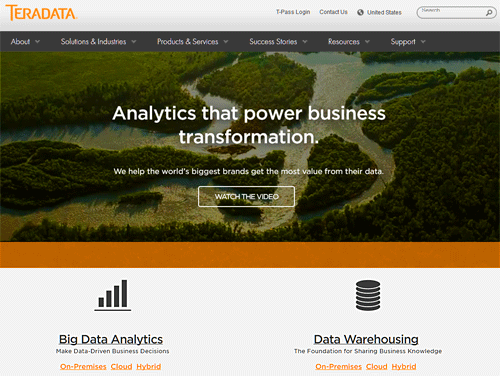
Have you heard about Teradata? If you were engaged in the creation of a large data warehouse, then, most likely, heard. Teradata has been a history since the late 1970s. It was then that she began work on solutions that later became known as “data warehouses”. In 1992, Teradata built the first terabyte database for Wal-Mart. Since then, the word "Teradata" is constantly mentioned in the conversations of experts on corporate data storage systems.
The capabilities of the Teradata Database relate to very large databases. This system is well suited to support recent trends such as big data research, business analytics, the Internet of things. Teradata released version 15.10 of its relational database at the beginning of 2015.
IBM Informix
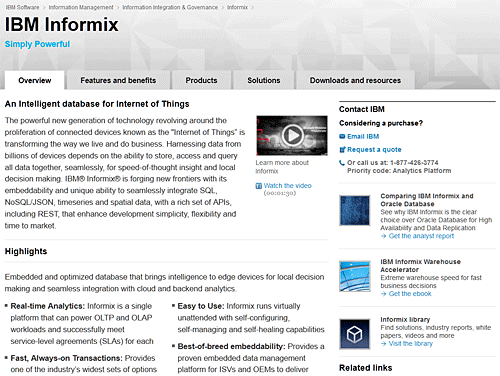
As you can see, there is another IBM development on our list. The company offers a wide range of options for object-relational DBMS Informix . It is promoted as an intelligent database that can be deployed on multiple platforms.
Often associated with educational institutions, Informix entered the corporate world and ranked first in terms of customer satisfaction. Users of this DBMS are usually quite complimentary about its low cost, the need for a small amount of maintenance and high reliability.
Ingres

Ingres relational DBMS is highly relevant in the corporate market, in addition, it is one of the old-timers of the database world. Work on it began in the early 1970s.
Ingres has an attractive pricing model, which can mean a reduction in the total cost of ownership of the system. This system boasts advanced capabilities for switching to it from more expensive DBMS. In addition, it is distinguished by the high safety performance required to comply with HIPAA requirements and the Sarbanes-Oxley Act.
The latest corporate version of Ingres is 10.2. It came out in 2015, presenting support for geospatial data types, remote GCA clients, UTF-8 transliteration, DBMS authentication, and other new features.
In June 2016, the Ingres 11 Technical Preview was released for testing.
Amazon SimpleDB
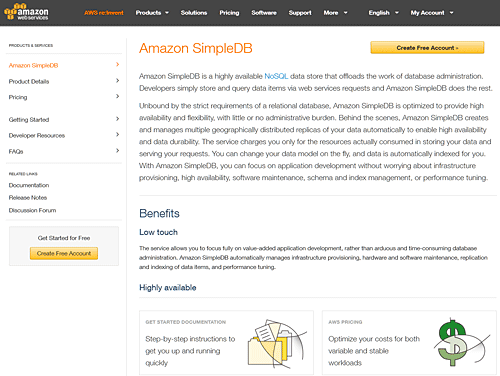
This is the eleventh item on our list. You can consider it a dessert for the main ten dishes.
At first glance, the concepts of “Amazon” and “DBMS” may not seem quite compatible, but in reality this is not the case, especially today, in the era of cloud computing. SimpleDB (Simple Database Service) offers organizations a simple, flexible, and inexpensive alternative to traditional DBMSs.
SimpleDB allows users to store data and work with them through requests to web services. It features scalability, high speed, minimal service requirements and integration with other Amazon services. Getting started with SimpleDB is free.
Results
There is no one correct solution for all tasks of working with data. There is no perfect corporate database. Each of them has its pros and cons, which, moreover, is very much dependent on the specifics of the business.
The best thing you can do in order to choose a suitable DBMS is to analyze everything that the market offers, taking into account the specific features of a particular organization.
We hope our story about the leading corporate DBMS of 2016 made a feasible contribution to the selection of a system that suits you.
Source: https://habr.com/ru/post/311422/
All Articles